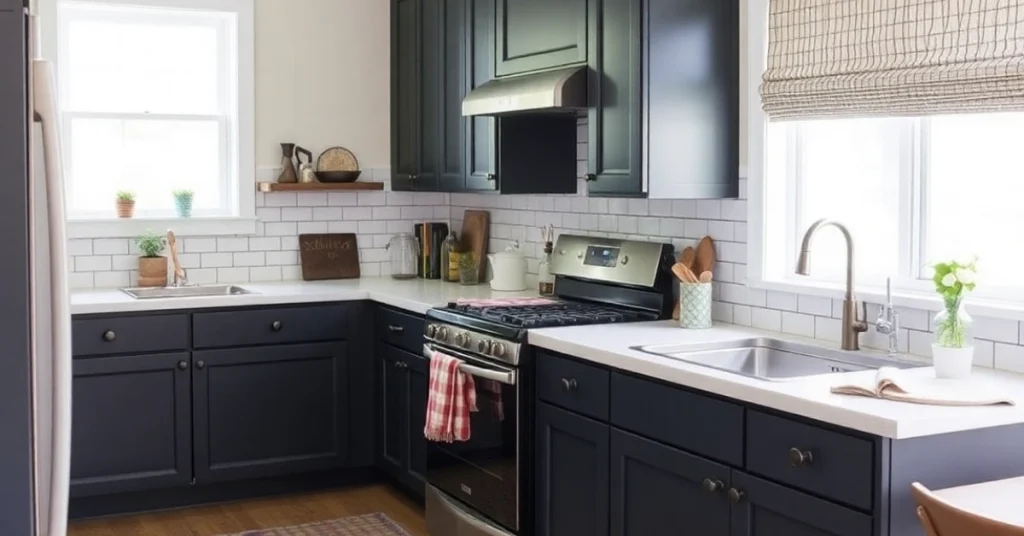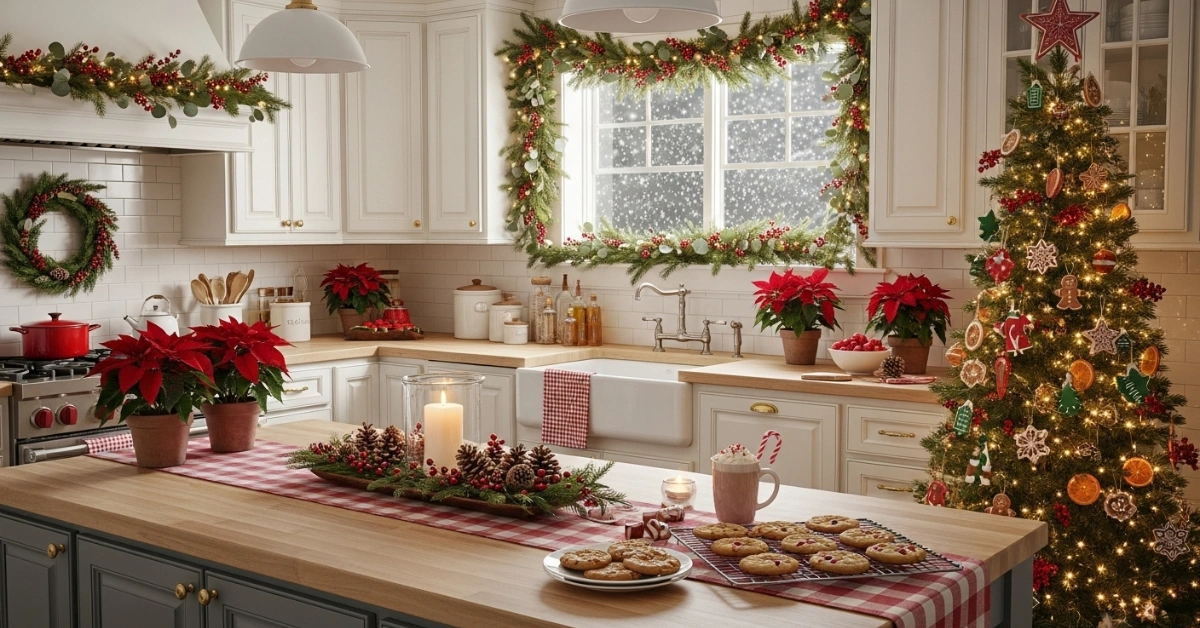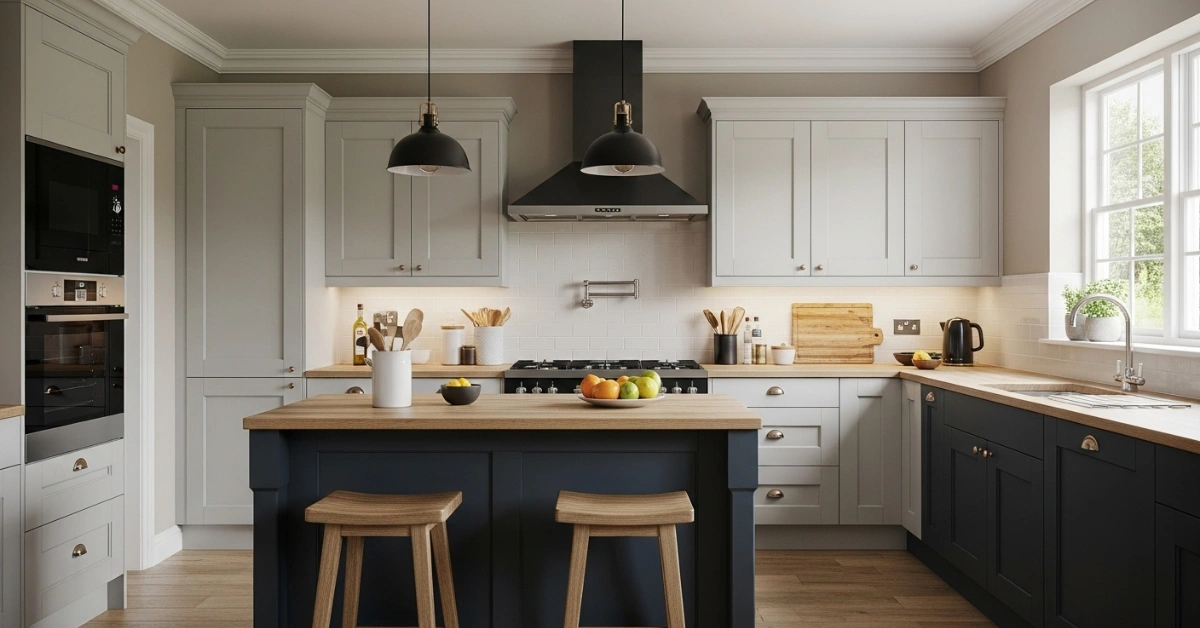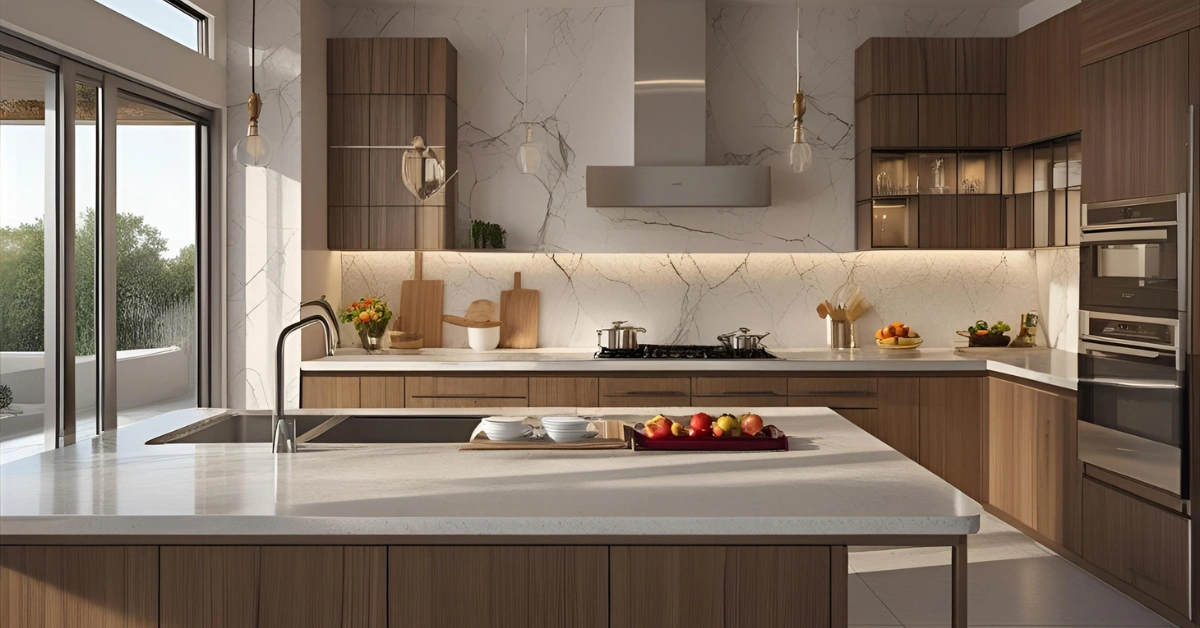Dark Cottagecore Kitchen: 22 Cozy, Timeless Design Ideas

Kitchens are often the heart of a home, but creating a space that feels both inviting and unique can be challenging. Many homeowners struggle to balance warmth, functionality, and style, especially when drawn to rustic, nature-inspired aesthetics like cottagecore. A dark cottagecore kitchen solves this by blending moody, earthy tones with cozy, vintage charm, offering a perfect retreat from the hustle of modern life. This style evokes nostalgia, celebrates imperfections, and creates a welcoming atmosphere where memories are made.
In this guide, we’ll explore how to design a dark cottagecore kitchen that’s both practical and beautiful. From color palettes to decor ideas, you’ll find 22 actionable tips, real-world examples, and expert insights to craft a kitchen that feels like a warm hug. Whether you’re renovating or refreshing your space, this article will inspire you to create a kitchen that’s uniquely yours.

What Is Dark Cottagecore? Understanding the Aesthetic
Cottagecore celebrates simplicity, nature, and rustic charm, drawing inspiration from pastoral lifestyles. The “dark” twist adds depth with moody hues like forest green, charcoal, or deep burgundy, creating a cozy yet sophisticated vibe. Unlike bright, airy cottagecore kitchens, a dark cottagecore kitchen leans into richer tones, textured materials, and vintage elements to evoke warmth and intimacy.
This aesthetic is perfect for those who love:
- Natural materials: Think wood, stone, and wrought iron.
- Vintage touches: Antique hardware, reclaimed furniture, and heirloom dishware.
- Moody ambiance: Deep colors paired with warm lighting for a snug feel.

Interior designer Sarah Thompson, who specializes in rustic designs, explains, “A dark cottagecore kitchen is about creating a space that feels lived-in and soulful. It’s less about perfection and more about storytelling through textures and tones.”
Choosing the Perfect Color Palette for Your Dark Cottagecore Kitchen
Color sets the mood in any kitchen, and a dark cottagecore kitchen thrives on rich, earthy tones. Here’s how to choose and apply your palette effectively:
Core Colors
- Forest Green: A versatile, nature-inspired hue that pairs well with wood and brass.
- Charcoal Gray: Adds depth and sophistication, ideal for cabinets or walls.
- Deep Burgundy: Brings warmth and a touch of drama, perfect for accent walls.
- Muted Black: Creates a bold backdrop that highlights natural textures.

Accent Colors
- Cream or Ivory: Softens the mood for countertops or backsplashes.
- Warm Beige: Complements wood tones for a cohesive look.
- Muted Gold: Adds subtle elegance through hardware or light fixtures.
Tip: Paint cabinets in a deep color like forest green and pair with cream walls for balance. According to a 2023 Houzz report, 62% of homeowners prefer bold cabinet colors to create a statement in their kitchens.
Example: In my friend’s Vermont home, she painted her kitchen cabinets a matte charcoal and added brass handles. The result was a cozy, timeless space that felt both modern and rustic.

Cabinetry and Storage: Blending Function with Charm
Cabinets are a focal point in any dark cottagecore kitchen, combining practicality with aesthetic appeal. Here’s how to get it right:
Cabinet Styles
- Shaker-Style Cabinets: Simple, clean lines that feel timeless.
- Glass-Fronted Cabinets: Showcase vintage dishware or glassware.
- Reclaimed Wood: Adds texture and history to the space.

Hardware Choices
- Opt for brass or bronze knobs for a warm, vintage touch.
- Consider wrought iron pulls for a more rustic feel.
- Mix and match hardware for an eclectic, collected look.
Tip: Sand down new cabinets lightly for a distressed, lived-in appearance. Interior designer Emily Harper suggests, “Imperfect finishes make a kitchen feel authentic. A slightly worn look tells a story.”
Storage Ideas:
- Use open shelving to display ceramic jars, woven baskets, or antique cookware.
- Install a pot rack with wrought iron for both function and charm.
- Add a vintage hutch for extra storage and a focal point.

Countertops and Backsplashes: Textures That Tell a Story
Countertops and backsplashes are opportunities to add texture and personality to your dark cottagecore kitchen. Here’s what works:
Countertop Materials
- Butcher Block: Warm, natural wood that’s budget-friendly and durable.
- Soapstone: A dark, matte stone with a soft, tactile feel.
- Marble: Veined patterns add elegance, though it requires maintenance.

Backsplash Ideas
- Handmade Ceramic Tiles: Opt for earthy tones like terracotta or sage green.
- Brick or Stone: Exposed brick or stacked stone adds rustic charm.
- Patterned Tiles: Subtle floral or geometric designs nod to vintage aesthetics.
Example: In a recent kitchen renovation, a homeowner chose soapstone countertops paired with a terracotta tile backsplash. The combination felt grounding and perfectly complemented their forest green cabinets.
Tip: Seal natural stone countertops to prevent staining, especially in a busy kitchen. Use a matte sealant to maintain the cottagecore vibe.

Flooring: Grounding Your Dark Cottagecore Kitchen
Flooring anchors the aesthetic of a dark cottagecore kitchen. Choose materials that feel natural and durable:
- Wide-Plank Hardwood: Oak or walnut in dark stains for warmth.
- Terracotta Tiles: Earthy and timeless, ideal for rustic charm.
- Slate Tiles: Dark, natural stone for a moody, grounded feel.
Tip: Add a patterned runner rug in muted tones to soften the space and add texture. A 2024 study by the National Kitchen and Bath Association found that 78% of homeowners prefer natural flooring materials for their kitchens.

Maintenance Note: Seal terracotta or slate tiles to protect against spills and wear. Regular sweeping and occasional waxing keep wood floors looking their best.
Lighting: Creating a Warm, Inviting Glow
Lighting is crucial in a dark cottagecore kitchen to prevent the space from feeling heavy. Here’s how to strike the right balance:
Types of Lighting
- Pendant Lights: Wrought iron or brass pendants over islands add charm.
- Chandeliers: A small, rustic chandelier creates a focal point.
- Under-Cabinet Lighting: Warm LED strips highlight countertops.

Bulb Choices
- Use warm white bulbs (2700K–3000K) for a cozy glow.
- Avoid harsh, cool-toned lighting that feels clinical.
Tip: Layer lighting with a mix of overhead, task, and accent lights. Designer Laura Jenkins notes, “Lighting is like jewelry for a kitchen it elevates the mood and highlights the beauty of the space.”
Example: A homeowner in Oregon installed vintage-inspired brass pendants over their kitchen island, paired with dimmable under-cabinet lights. The result was a warm, inviting space perfect for evening gatherings.
Decor and Accessories: Adding Soul to Your Kitchen
Decor brings a dark cottagecore kitchen to life, infusing it with personality and charm. Here are some ideas:
Key Decor Elements
- Vintage Dishware: Display antique plates or mugs on open shelves.
- Woven Baskets: Use for storage or as decorative accents.
- Dried Herbs or Flowers: Hang bundles of lavender or rosemary for a rustic touch.

Textiles
- Linen Curtains: Opt for neutral or muted tones to soften windows.
- Patterned Rugs: Floral or geometric patterns add warmth underfoot.
- Cloth Napkins: Choose natural fabrics in earthy colors.
Tip: Source decor from thrift stores or flea markets for authentic, budget-friendly finds. A 2023 Better Homes & Gardens survey found that 65% of homeowners incorporate secondhand items into their kitchen designs.
Example: In a cozy Maine cottage, the homeowner hung dried eucalyptus above the sink and placed a vintage bread box on the counter. These small touches made the kitchen feel lived-in and personal.
Appliances and Fixtures: Blending Modern with Rustic
Modern appliances can coexist with the dark cottagecore kitchen aesthetic if chosen thoughtfully. Here’s how:
Appliance Finishes
- Matte Black: Sleek and understated, blends with dark cabinetry.
- Stainless Steel: Adds contrast while maintaining functionality.
- Retro-Inspired: Brands like Smeg offer vintage-style appliances in earthy tones.

Sink and Faucet Options
- Farmhouse Sink: A white or black ceramic sink adds classic charm.
- Brass or Bronze Faucets: Warm metals enhance the rustic vibe.
- Pull-Down Faucets: Combine modern convenience with vintage style.
Tip: Look for appliances with matte or textured finishes to avoid a too-modern look. Designer Mark Evans advises, “Choose fixtures that feel like they’ve been in the kitchen for decades, even if they’re brand new.”
Layout and Flow: Designing a Functional Dark Cottagecore Kitchen
A well-designed layout ensures your dark cottagecore kitchen is as practical as it is beautiful. Consider these tips:
Popular Layouts
- U-Shaped Kitchen: Ideal for ample storage and counter space.
- L-Shaped Kitchen: Great for open-plan homes with a cozy nook.
- Island-Centric: A central island adds prep space and a gathering spot.

Workflow Tips
- Follow the kitchen work triangle (sink, stove, refrigerator) for efficiency.
- Ensure at least 36 inches of walkway space for easy movement.
- Place frequently used items within arm’s reach of the prep area.
Example: In a small Seattle apartment, the homeowner opted for an L-shaped layout with a butcher block island. The setup maximized space while maintaining a cozy, cottagecore feel.
Tip: If space allows, add a small dining nook with a wooden table and mismatched chairs for extra charm.
Budget-Friendly Tips for a Dark Cottagecore Kitchen
Creating a dark cottagecore kitchen doesn’t have to break the bank. Here are cost-effective ideas:
- Paint Existing Cabinets: A fresh coat of forest green or charcoal transforms old cabinetry.
- Shop Secondhand: Find vintage hardware, decor, or furniture at thrift stores.
- DIY Backsplash: Use peel-and-stick tiles in a rustic pattern for an affordable update.
- Refinish Countertops: Apply a concrete overlay to mimic stone at a fraction of the cost.
Example: A couple in Colorado revamped their kitchen for under $5,000 by painting cabinets, adding a butcher block countertop, and sourcing vintage decor from local markets.

Tip: Prioritize one or two statement pieces, like a farmhouse sink or brass chandelier, and save on smaller elements like decor or hardware.
Inspiration Gallery: 5 Dark Cottagecore Kitchen Examples
To spark your creativity, here are five real-world-inspired dark cottagecore kitchen ideas:
The Forest Green Haven:
Matte green cabinets, soapstone counters, and brass pendants create a cozy retreat.

The Charcoal Cottage:
Charcoal cabinets paired with a white farmhouse sink and terracotta tiles for warmth.

The Burgundy Nook:
A burgundy accent wall with cream cabinets and woven baskets for a bold yet inviting look.

The Rustic Retreat:
Reclaimed wood beams, slate flooring, and vintage dishware for a lived-in feel.

The Moody Eclectic:
Black cabinets, patterned tiles, and mismatched chairs for a quirky, charming vibe.
Tip: Save images of kitchens you love on platforms like Pinterest to refine your vision before starting your project.

Common Mistakes to Avoid in a Dark Cottagecore Kitchen
Even with the best intentions, mistakes can derail your design. Here’s what to watch out for:
- Overloading with Dark Colors: Balance moody tones with lighter accents to avoid a heavy feel.
- Ignoring Lighting: Insufficient lighting can make the space feel gloomy.
- Overcrowding Decor: Too many accessories can clutter the space and detract from the aesthetic.
- Skipping Maintenance: Natural materials like wood and stone require regular care to stay beautiful.
Tip: Test paint samples in your kitchen’s lighting before committing to a color. Natural light can dramatically affect how dark tones appear.
Conclusion: Create Your Dream Dark Cottagecore Kitchen
A dark cottagecore kitchen is more than a design trendit’s a lifestyle that celebrates warmth, nostalgia, and connection to nature. By blending moody colors, natural materials, and vintage touches, you can create a space that’s both functional and soulful. Whether you’re starting from scratch or refreshing an existing kitchen, the tips and ideas in this guide will help you craft a space that feels like home.
Ready to transform your kitchen? Start by choosing one element like a bold cabinet color or a vintage chandelier and build your design from there. Share your dark cottagecore kitchen journey in the comments or connect with a local designer to bring your vision to life!






